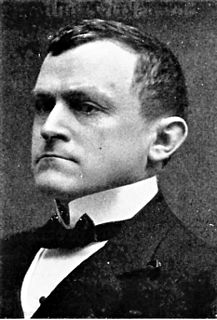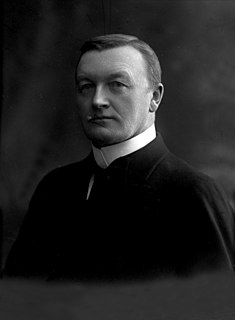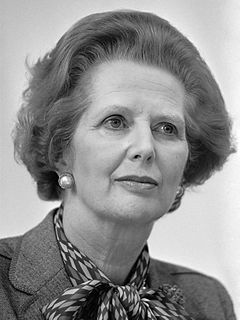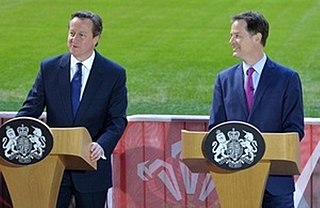The Conservative Party, officially the Conservative and Unionist Party, and also known colloquially as the Tories, Tory Party, or simply the Conservatives, is a political party in the United Kingdom. Ideologically, the Conservatives sit on the centre-right of the political spectrum. The Conservatives have been in government since 2010 and as of 2019, hold an overall majority in the House of Commons with 365 Members of Parliament. The party also has 245 unelected members of the House of Lords, 8 members of the London Assembly, 30 members of the Scottish Parliament, 11 members of the Welsh Parliament and 7,430 local authority councillors.

Andrew Bonar Law was a British Conservative politician who served as Prime Minister of the United Kingdom from 1922 to 1923.

The Secretary of State for Education, also referred to as the Education Secretary, is a senior Minister of the Crown within the Government of the United Kingdom, and head of the Department for Education. The office forms part of the British Cabinet.

The Secretary of State for Transport, also referred to as the Transport Secretary, is the member of the cabinet responsible for the British Department for Transport. The office used to be called the Minister of Transport and has been merged with the Department for the Environment at various times.

The Conservative Party is a liberal-conservative political party in Norway. It is the major party of the Norwegian centre-right, and the leading party in the governing Solberg cabinet. The current party leader is the Prime Minister Erna Solberg. The party is a member of the International Democrat Union and an associate member of the European People's Party.

Bernhard Cornelius Brænne was a Norwegian factory owner and member of the Norwegian Parliament with the Conservative Party.

Hans Jørgen Darre-Jenssen was a Norwegian engineer and politician for the Free-minded Liberal Party. He was the Minister of Labour from 1910 to 1912, and thereafter served as director of the Norwegian State Railways.

Bernt Holtsmark was a Norwegian farmer and politician for the Conservative Party and the Liberal Left Party. He was a four-term member of the Parliament of Norway, and served as Minister of Agriculture from 1910 to 1912. He was also known for establishing the agricultural college at Sem in his native Asker.

The Liberal government of the United Kingdom of Great Britain and Ireland that began in 1905 and ended in 1915 consisted of two ministries: the first led by Henry Campbell-Bannerman and the final three by H. H. Asquith.
The Royal Norwegian Ministry of Trade and Industry was a Norwegian ministry responsible for business, trade and industry. On 1 January 2014 it was merged into Ministry of Trade, Industry and Fisheries. From 2013 it was led by Monica Mæland, who continued as minister of trade, industry and fisheries from 2014 to 2018.
The Coalition Party was a Norwegian political coalition drawn from the Conservative Party, the Moderate Liberal Party and independent Liberals. Its main issues were opposition to the Liberal Party's political union radicalism, as well as to the rising growth of social democracy. Originally formed to pursue a more careful negotiating line towards Sweden, the party turned around and took part in Michelsen's Cabinet, which carried through the dissolution of the union between Norway and Sweden in 1905. The coalition's leading members included Christian Michelsen himself, Wollert Konow (SB) and Bjørnstjerne Bjørnson.
The Free-minded Liberal Party was a political party in Norway founded in 1909 by the conservative-liberal faction of the Liberal Party. The party cooperated closely with the Conservative Party and participated in several short-lived governments, including two headed by Free-minded Prime Ministers. In the 1930s the party changed its name to the Free-minded People's Party and initiated cooperation with nationalist groups. The party contested its last election in 1936, and was not reorganised in 1945.

Bratlie's Cabinet was a Norwegian cabinet, formed by a coalition of the Conservative Party and the Free-minded Liberal Party. It sat from 20 February 1912 to 31 January 1913.

Bahr Halvorsen's First Cabinet governed Norway between 21 June 1920 and 22 June 1921. The Conservative and Free-minded Liberal Party cabinet was led by Otto Bahr Halvorsen. It had the following composition:
In Norway, a State Secretary is a partisan political position within the executive branch of government. Contrary to the position Secretary of State in many other countries, the Norwegian State Secretary does not head his or her Ministry, rather, they are second in rank to a Minister. Resembling a de facto vice minister, the State Secretary, however, cannot attend a Council of State, and does not act as a temporary Minister in case of illness or other leave of absence.

Margaret Thatcher was Prime Minister of the United Kingdom from 4 May 1979 to 28 November 1990, during which time she led a Conservative majority government. She was the first woman to hold that office. During her premiership, Thatcher moved to liberalise the British economy through deregulation, privatisation, and the promotion of entrepreneurialism.

The Michelsen's Cabinet was a Norwegian cabinet, formed by a coalition of the Liberal Party, the Conservative Party, the Moderate Liberal Party and the Coalition Party. It governed Norway between 11 March 1905 and 23 October 1907. It entered office as part of the build-up for the dissolution of the union between Norway and Sweden in 1905. It had the following composition:

The Cameron–Clegg coalition was formed by David Cameron and Nick Clegg when Cameron was invited by Queen Elizabeth II to form a new administration, following the resignation of Prime Minister Gordon Brown on 11 May 2010 after the general election on 6 May. It was the UK's first coalition government since the Churchill caretaker ministry. The coalition was led by Cameron as Prime Minister with Clegg as Deputy Prime Minister and composed of members of both Cameron's Conservative Party and Clegg's Liberal Democrats.

Wollert Konow was a Norwegian politician and farmer.













